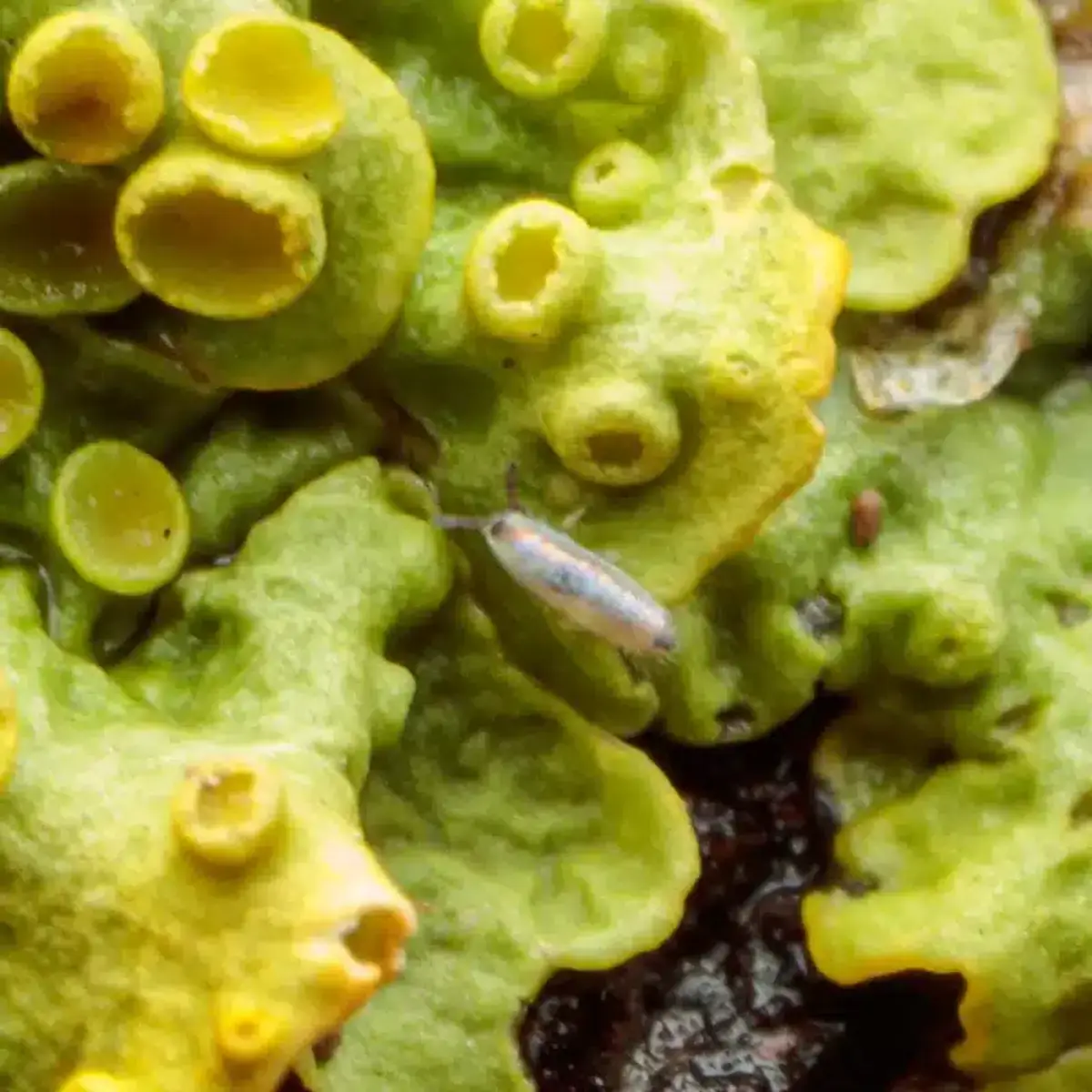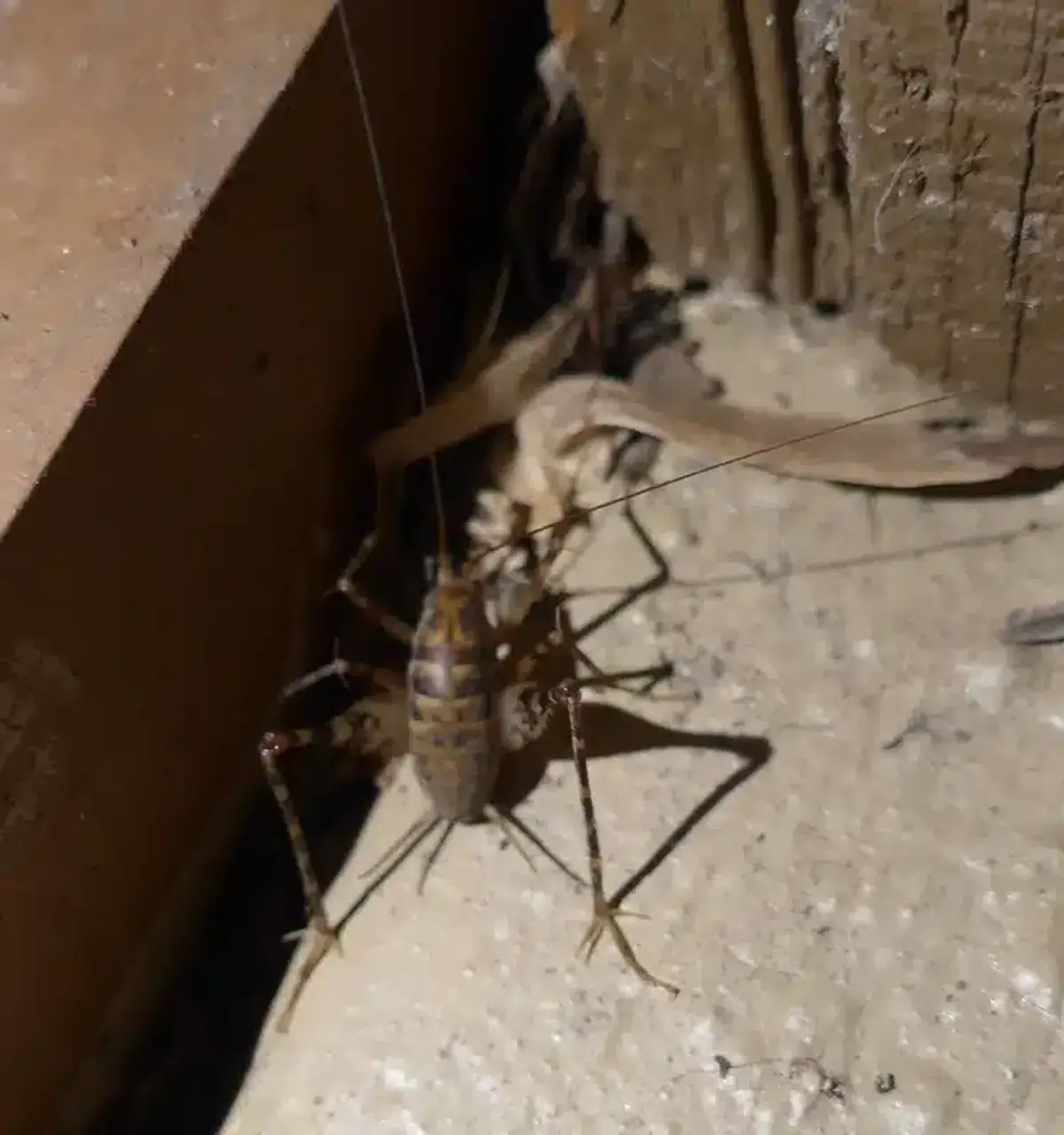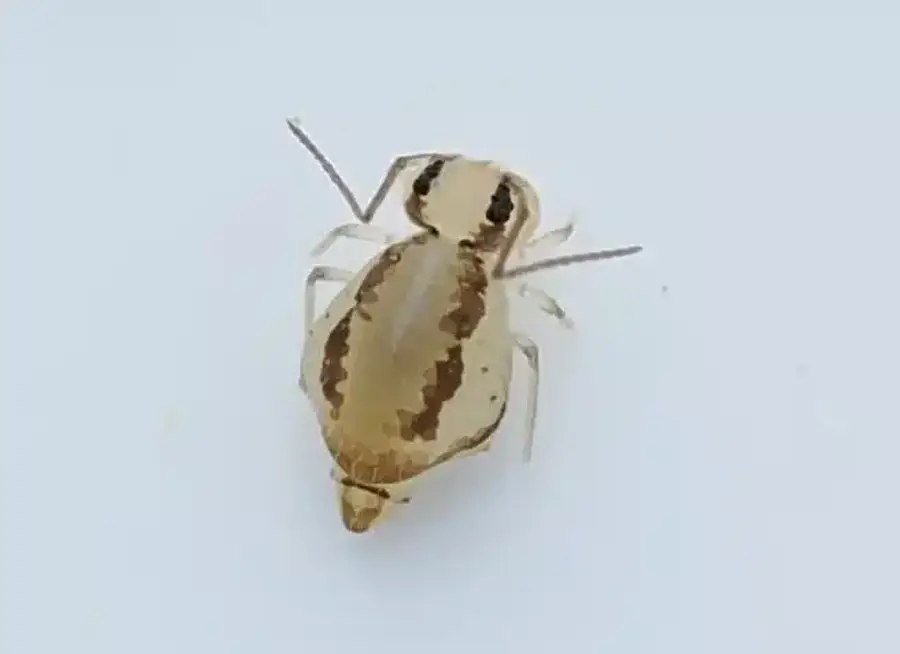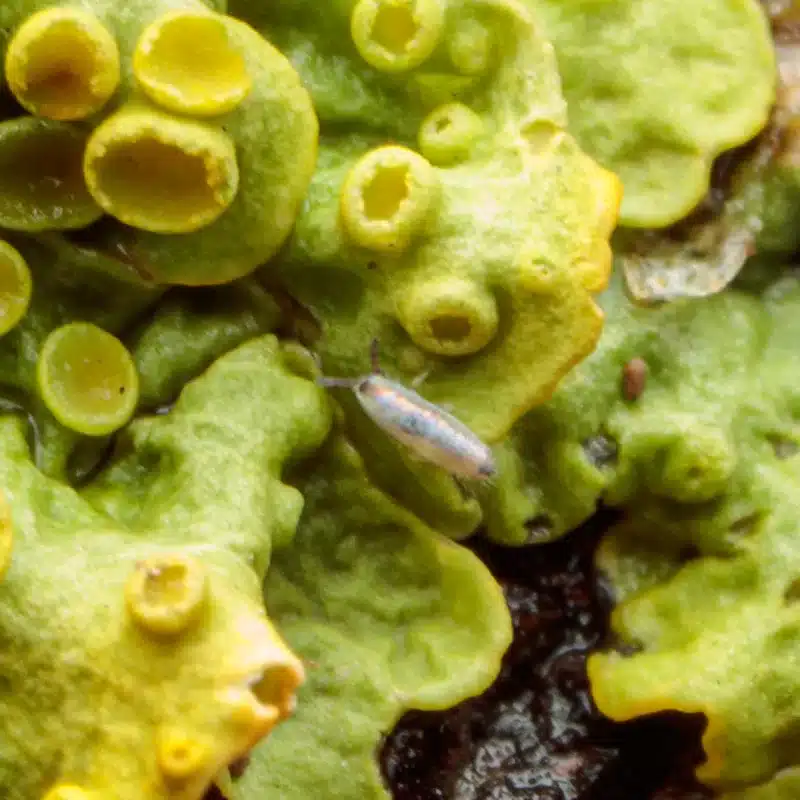Have you ever noticed tiny insects suddenly springing away when you turn on the bathroom light? Or spotted small creatures hopping across your carpet? These bugs that jump can be confusing to identify, but their jumping behavior is actually one of the best clues for figuring out what you’re dealing with.
As a licensed pest control technician working in the DC metro area since 2015, I’ve responded to countless calls where homeowners described mysterious jumping insects. The good news is that jumping behavior helps narrow down the possibilities significantly. Some jumping bugs indicate serious problems that need immediate attention, while others are mostly harmless.
Understanding which bugs jump and what that means for your home can help you determine when to take action and when to simply relocate the critter outdoors.
Common Types of Jumping Bugs in Homes
Several different insects use jumping as their primary escape method. Each has distinct characteristics that make identification easier once you know what to look for.
The most common jumping insects found indoors include springtails, fleas, jumping spiders, camel crickets, field crickets, click beetles, and occasionally young cockroach nymphs. While they all jump, their reasons for being in your home vary dramatically.
Springtails: The Bathroom Jumping Bugs

Springtails are probably the most common bugs that jump in bathrooms and basements. These tiny insects measure just 1-3 mm long and appear as small gray, white, or dark specks that suddenly hop when disturbed.
In my experience responding to springtail calls, homeowners are usually surprised when they see dozens of these insects hopping on damp surfaces. The jumping happens because springtails have a specialized appendage called a furcula that snaps downward like a catapult. They can jump up to 100 times their body length - that’s like a person jumping over a 30-story building.
What makes springtails significant is that they’re moisture indicators. When I find springtails in a home, I know there’s likely a humidity or water leak issue that needs addressing.
What does the science say?
According to University of Maryland Extension, these insects require high humidity to survive and typically appear when relative humidity exceeds 50%. Research shows that springtails serve as reliable indicators of moisture problems that can lead to structural damage if left untreated.
Fleas: The Pet and Carpet Jumping Bugs
Fleas are another common type of jumping bug that homeowners encounter, especially those with pets. These 1-3 mm insects are laterally flattened and reddish-brown in color.
Cat fleas can jump horizontally about 8 inches and vertically around 5 inches. That might not sound impressive, but for an insect their size, it’s remarkable.
What does the science say?
Research published in Medical and Veterinary Entomology shows that fleas achieve takeoff velocities of nearly 3.6 meters per second. This incredible acceleration allows them to jump distances equivalent to a human leaping over a 30-story building.
Health Warning
Unlike springtails, fleas are a health concern because they bite humans and can transmit diseases. They’re also much harder to eliminate once established.
If you’re seeing jumping insects on carpets or around pet areas, fleas should be your primary suspect.
Jumping Spiders: The Beneficial Hunters

Jumping spiders are among the most impressive jumpers in the insect world, capable of leaping 29-40 times their body length. These spiders are easily recognizable by their four large front eyes and compact, robust build.
I often encounter jumping spiders during inspections in wooded neighborhoods. When homeowners see their erratic jumping movement on windowsills or eaves, they sometimes panic. However, these spiders are actually beneficial because they hunt other insects.
What sets jumping spiders apart from other bugs that jump is their hunting behavior. They anchor themselves with silk before leaping, allowing them to make precise jumps toward prey. This controlled jumping is very different from the chaotic escape jumps of springtails or fleas.
Camel Crickets: The Basement Jumping Bugs

Camel crickets, also called cave crickets, are probably the most startling bugs that jump you’ll encounter indoors. These large insects can jump up to 3 feet - often directly toward the person who disturbed them.
These crickets are wingless and silent, with a distinctive humped back and very long hind legs. They typically measure 13-38 mm long and prefer cool, moist areas like basements, crawl spaces, and garages.
What does the science say?
North Carolina State Extension notes that camel crickets often form large aggregations, especially after extreme weather events drive them indoors seeking shelter. Their mass migrations can result in hundreds of these jumping insects clustering in basements and crawl spaces.
Jump Distances and Behavior Patterns
Understanding how far different insects can jump helps with identification. Each species has characteristic jump patterns that serve as diagnostic clues.
Springtails produce rapid, chaotic “popcorn” jumps that send them in random directions. Fleas make more deliberate lateral jumps aimed toward heat and carbon dioxide sources. Jumping spiders leap with precision toward specific targets.
Camel crickets use their powerful hind legs for dramatic escape jumps that can span several feet. Meanwhile, click beetles perform a unique “flipping” motion to right themselves when on their backs.
What Triggers Jumping Bug Behavior
Trigger Recognition Guide
Different jumping insects respond to different stimuli. Recognizing these triggers can help you identify what you’re dealing with:
- Light exposure: Springtails and camel crickets often jump when suddenly exposed to bright light
- Vibration: Fleas respond to footsteps and movement on floors
- Heat and CO2: Fleas jump toward warm-blooded hosts
- Visual movement: Jumping spiders leap toward moving prey
- Physical disturbance: Most jumping insects will hop when touched or threatened
Identifying Concerning vs. Harmless Jumping Bugs
Not all bugs that jump require the same response. Some indicate serious problems, while others are temporary nuisances or even beneficial.
High Priority: Jumping Bugs That Indicate Problems
Fleas and springtails top the list of concerning jumping insects. Fleas bite humans and pets, potentially transmitting diseases like murine typhus. They also reproduce rapidly in carpet fibers and pet bedding.
Springtails, while harmless themselves, indicate moisture problems that can lead to mold, wood rot, and other structural issues. When I find springtails during inspections, we always investigate the underlying moisture source.
Young cockroach nymphs that exhibit hopping behavior also warrant immediate attention. In our area, German, American, and Oriental roaches are common, and early identification prevents larger infestations.
Low Priority: Mostly Harmless Jumping Bugs
What does the science say?
Clemson University’s Home and Garden Information Center notes that jumping spiders are highly effective biological control agents, consuming dozens of pest insects daily including flies, mosquitoes, and small beetles.
Click beetles occasionally wander indoors but don’t reproduce in houses. Their dramatic flipping behavior can startle homeowners, but they’re essentially harmless.
Field crickets and grasshoppers that enter homes are usually temporary visitors attracted to lights. They rarely establish indoor populations in our Mid-Atlantic climate.
Where Different Jumping Bugs Are Found
Location is one of the best clues for identifying bugs that jump. Each species has preferred habitats that reflect their needs and behaviors.
Bathroom and Moisture Areas - Springtail Bug Zones
Springtails dominate moist indoor environments. I regularly find them around sink overflows, bathtub edges, potted plants, and areas with plumbing leaks. They may also appear near windows during heavy rains.
These tiny jumping insects need humidity levels above 50% to survive. When I respond to springtail calls, the root problem is almost always excessive moisture somewhere in the home.
Carpets and Pet Areas - Flea Jump Zones
Fleas concentrate in areas where pets spend time - carpeted rooms, pet bedding, and furniture where animals rest. Adult fleas jump onto hosts to feed, while larvae develop deep in carpet backing.
If you’re seeing jumping insects specifically in carpeted areas or around pet beds, fleas are the most likely culprit. Our comprehensive flea guide provides detailed identification and treatment information.
Basements and Dark Spaces - Cricket Jump Zones
Camel crickets prefer cool, dark, humid spaces like basements, crawl spaces, garages, and areas under porches. They often hide in corners where walls meet floors.
These impressive jumpers can form large aggregations, especially during weather extremes that drive them indoors seeking shelter.
Window Areas and Walls - Spider Jump Zones
Jumping spiders are often found on windowsills, wall corners, and around light fixtures where they hunt flying insects. They’re most active during daylight hours.
In wooded neighborhoods especially, jumping spiders may enter homes while pursuing prey insects attracted to indoor lighting.
Effective Techniques for Catching and Identifying Jumping Insects
Proper identification requires getting a close look at the insect. Since bugs that jump are naturally elusive, specific techniques help with capture and examination.
The White Paper Test for Jumping Bug ID
One of the best identification methods is the white paper drop test. Gently encourage the insect onto a white index card or paper. This neutral background makes size, color, and body shape much easier to see.
Watch how the insect moves on the paper. Does it jump chaotically like a springtail, make directed leaps like a flea, or move deliberately like a spider?
Collection Methods for Jumping Bugs
For permanent specimens, clear pill bottles or small deli containers work well. Springtails are easiest to catch with a slightly damp paintbrush - they stick to the bristles.
Jumping spiders and larger insects can be captured with an inverted glass and index card. Slide the card under the glass to trap the insect for examination.
Photography Tips for Bug Identification
If possible, take macro photos that include a millimeter scale or coin for size reference. This is especially important for distinguishing between springtails and fleas, which can look similar at first glance.
Focus on body shape, leg length, and any distinctive markings. These details help confirm identification when consulting reference materials.
Prevention Strategies for Jumping Bugs Based on Species
Effective prevention depends on understanding why different bugs that jump enter homes. Each species requires targeted approaches based on their specific needs and behaviors.
Moisture Control for Springtails
Since springtails indicate moisture problems, prevention focuses on humidity reduction. Run dehumidifiers in basements and crawl spaces, fix plumbing leaks promptly, and ensure proper ventilation in bathrooms.
Check potted plants for overwatering - soggy soil is a prime springtail habitat. Our bathroom pest guide covers additional moisture management strategies.
Pet Treatment for Fleas
Flea prevention requires year-round pet treatment combined with environmental management. Vacuum carpets thoroughly and dispose of bags immediately, as flea eggs can continue developing inside vacuum cleaners.
Wash pet bedding in hot water weekly and treat carpeted areas where pets spend time. Professional treatment may be necessary for established infestations.
Structural Exclusion for Jumping Pest Prevention
For most jumping insects, sealing entry points prevents problems. Install weather stripping around doors, repair torn screens, and caulk cracks in foundations.
Reduce outdoor lighting that attracts insects, or switch to yellow “bug lights” that are less attractive to flying insects that jumping spiders hunt.
Habitat Modification to Eliminate Bug Attractants
Remove leaf litter and debris from around foundations, especially for camel cricket prevention. Install vapor barriers in crawl spaces and improve drainage around basements.
Keep firewood stored away from the house and eliminate unnecessary moisture sources in outdoor areas.
Using Jumping Behavior as a Diagnostic Tool
Experienced pest control professionals use jumping behavior as a quick field diagnostic. The style, distance, and triggers for jumping often point to specific species before detailed examination.


Jumping Bug Behavior Comparison
| Bug Type | Jump Style | Jump Distance |
|---|---|---|
| Springtails | Chaotic “popcorn” jumps | 100x body length |
| Fleas | Directed toward heat | 8 inches horizontal |
| Jumping Spiders | Precise with silk line | 29-40x body length |
| Camel Crickets | Dramatic escape jumps | Up to 3 feet |
Rapid vertical “popcorn” jumping from tiny insects usually indicates springtails. Long lateral jumps toward heat sources suggest fleas. Precise, directed leaps with silk draglines point to jumping spiders.
When homeowners describe insects that jump toward them when lights turn on, camel crickets are the most likely explanation. This “toward-you” jumping behavior is characteristic of these basement-dwelling insects.
Jump Performance Indicators
The relationship between body size and jump distance provides additional diagnostic clues. Springtails and fleas achieve the most impressive ratios - over 100 times their body length.
Jumping spiders demonstrate precise control rather than maximum distance. Camel crickets combine large size with powerful legs for dramatic escape jumps that can span several feet.
When to Call Professional Pest Help
While many jumping insects are harmless or easily managed, some situations require professional intervention. Established flea infestations spread rapidly and resist DIY treatments.
Persistent springtail problems often indicate structural moisture issues that need professional diagnosis and repair. Similarly, hopping cockroach nymphs suggest developing infestations requiring targeted treatment.
Through my work with families in the DMV area for over 50 years, we’ve seen how early professional intervention prevents minor jumping bug issues from becoming major problems.
If you’re dealing with persistent bugs that jump in your home, proper identification is the first step toward effective control. Our registered technicians can help determine exactly what you’re seeing and develop a targeted approach for your specific situation.
Don’t let jumping insects take over your living spaces. Contact us at 703-683-2000 or email info@bettertermite.com for expert identification and treatment options tailored to your home’s needs.
Frequently Asked Questions
What are the tiny black bugs that jump in my bathroom?
+
These are most likely springtails, small jumping insects that thrive in moist environments. They appear when humidity levels are high and often indicate underlying moisture problems like leaks or poor ventilation that need attention.
How can I tell the difference between fleas and springtails?
+
Fleas are laterally flattened and reddish-brown, typically found in carpeted areas and around pets. Springtails are softer, more rounded, and usually gray or white, found in moist areas like bathrooms. Fleas jump toward heat sources while springtails jump chaotically in all directions.
Are jumping spiders dangerous to have in my house?
+
Jumping spiders are not dangerous and are actually beneficial because they hunt other pest insects. They don't build webs indoors or establish permanent populations. If you find them bothersome, simply relocate them outdoors rather than eliminating them.
Why do camel crickets jump toward me?
+
Camel crickets don't actually aim for people - they jump randomly when startled by sudden light or movement. Because they're often hiding in corners when you turn on lights, their escape jumps can appear directed toward you, but it's just coincidental positioning.
How do I get rid of springtails in my house?
+
Focus on moisture reduction rather than pesticides. Run dehumidifiers, fix any water leaks, improve ventilation, and reduce watering of indoor plants. Once humidity drops below 50%, springtails typically disappear on their own.
What jumping bugs indicate serious pest problems?
+
Fleas require immediate attention because they bite and reproduce rapidly. Young cockroach nymphs that hop also signal developing infestations. Springtails, while harmless themselves, indicate moisture problems that can lead to structural damage if not addressed.
Can click beetles damage my home?
+
Click beetles are harmless indoors and don't reproduce inside homes. They occasionally wander in through open doors but don't cause damage. Their dramatic flipping behavior when on their backs can be startling but is just their way of righting themselves.
How far can different jumping insects actually jump?
+
Springtails and fleas can jump over 100 times their body length. Jumping spiders leap 29-40 times their length with precision. Camel crickets can jump up to 3 feet horizontally. Click beetles flip themselves about 25 times their body length when righting themselves.
When should I call a professional for jumping bugs?
+
Contact professionals for established flea infestations, persistent springtail problems indicating structural moisture issues, or any hopping cockroach nymphs. These situations often require specialized treatment and may indicate larger problems needing expert diagnosis.
With five years of hands-on experience in the pest control industry, George Schulz is a registered technician with the Virginia Pest Management Association and a proud third-generation professional in a family business that's been protecting homes for over 57 years. He manages and trains a team of service pros while also leading internal research efforts—recently spearheading a deep-dive review of thousands of documents on pest control materials to hand-pick the most kid and pet friendly, most effective solutions tailored specifically for homes in the DC metro area.
